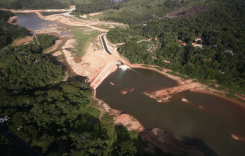Florida and Georgia have been fighting a water war for nearly four decades. Both states spent nearly $100 million on court costs.
Florida accuses the neighboring state of consuming too much water and endangering one of its most beautiful rivers: Apalachicola.
This river, which flows into the Gulf of Mexico, is a jewel of diversity: 40 species of amphibians, 50 types of mammals, 80 species of snakes, nearly 500 kinds of fish and molluscs, as well as 1300 types plants and birds live there.
The body of water, located in northwestern Florida, is recognized by the United Nations as a biosphere reserve. But this unique ecosystem is at the heart of a battle that is now before the US Supreme Court.
Linked by a watershed
According to Dan Tonsmeire, who has been the river’s keeper for 14 years, Apalachicola lacks fresh water due to drought and over-consumption by Atlanta residents and farmers in Georgia.
Atlanta is at the top of the watershed and serves first for its own needs. It is the Lanier Reservoir to the north, which supplies the city with water. The reservoir then flows southward into the Chattahoochee River, which supplies the Apalachicola River in Florida with fresh water.
According to Mr.Tonsmeire, the health of the Gulf of Mexico and Apalachicola Bay depend on the health of the river. “The river provides nutrients for hundreds of species in the early stages of their development,” he says.
Impact on fishing
It is the oyster fishery in Apalachicola Bay that has been most affected by the lack of fresh water. Oysters need unsalted water to reproduce. The fishery is dying in the bay, says Shannon Hartsfield, president of the Franklin County Seafood Fishermen’s Association.
That morning, on Apalachicola Bay, only four boats can be seen. On board, fishermen scrape the sandy bottoms in search of the precious mollusc.
“It was not uncommon, not so long ago, to see 70 to 80 boats crisscrossing the bay,” says Shannon Hartsfield.
This area of the Gulf Coast provided about 10% of all oysters in the United States and 90% of those in Florida.
“It’s terrible,” says Ronnie Custer, 57, who has spent his life fishing for the oyster. “Today, the bay is almost empty and I can not live fishing anymore.”
“Just six years ago,” says Ronnie, “I easily filled between 10 and 12 bags of oysters a day. Now it’s barely a bag. At that time, a good fisherman could earn between $40,000 and $70,000 a year.”
Georgia says do not overuse water
Atlanta and its metropolitan area of five million people defend themselves from being the source of the problems of the river and Apalachicola Bay. “We consume an average of 1.3% of the water in the basin,” says Katherine Zitsch, Water Management Manager.
“We have made enormous efforts to reduce our consumption,” she says, showing us the $1 billion water purification plant.
“The population of Atlanta has grown by one million since 2000 and we consume 20% less water,” says Zitsch.
Farmers blamed
The same goes for farmers, who reject Florida’s accusations. Casey Cox, 26, runs the family farm in Camilla, central Georgia. On her land, she grows corn, peanuts and soybeans.
According to her, farmers consume 30% less water than 20 years ago thanks to new watering techniques.
“With the touch of a button on my phone, I can operate or stop those giant sprinklers behind me,” says Casey. We also have a system for detecting the humidity of the earth to find out if it needs water. ”
Casey Cox is mostly frustrated that instead of finding solutions, Florida and Georgia have spent millions on lawsuits.
“Imagine,” she concluded, “if we had used all that money to invest in new technologies to reduce our consumption. ”
A complex issue
A third player, and not least, comes to mix cards in this complex water war between the two states. The Corps of Army Engineers controls the flow of rivers using five dams. But this federal organization has judicial immunity and is not involved in the case.
The special advocate appointed by the Supreme Court to unravel the record concludes that without the corps of engineers as a party, it will be difficult to come to a conclusion.
Florida and its fishermen blame them for poorly distributing water in the basin and depriving the Apalachicola River of fresh water in the spring and summer, when Atlanta residents water their lawn and wash their car, but where species breed in the bay.
“Atlanta is growing, says Shannon Hartsfield, and needs water. It is certain that the engineering corps will meet the needs [of city dwellers] before those of oyster fishermen. ”
Shared responsibilities
All parties bear some responsibility for this water war between Georgia and Florida, says Gil Rogers, director of the Southern Environmental Law Center.
“Atlanta consumes a lot of water in a region where there is little; Georgia still gives too much license for agriculture and some believe there has been overfishing in Florida.”
While everyone launches the ball, Dan Tomsmeire, the former guardian of the Apalachicola River, says there is urgency. He fears that if the water level does not increase, marine life and wildlife will never resume in the bay.
For Shannon Harstfield, it’s the joy of seeing her son do the same job as him who disappears. His boy would have taken over four generations of oyster fishermen from the Harstfield family.
“He was fishing with me every day before, but he had to get a new job because there are not enough oysters for everyone here,” said Harstfield. “It’s a reality that breaks my heart.”
There is no magic way to raise the level of the Apalachicola River in Florida while meeting the needs of the city and the countryside.
Atlanta, the farmers, the fishermen and the engineering corps will have to put some water in their wine if they want to save this unique but fragile ecosystem.
Molly Rielly was born and raised in Cleveland. As a journalist, Molly has contributed to many online publications including The Street and The Inquir. In regards to academics, Molly earned a degree in business from St. John’s University. Molly covers economy stories here at Cleveland Post Gazette.





